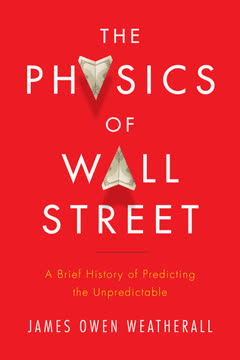Key Takeaways
1. Markets are not inherently stable or efficient
There is nothing like a revolution, the British historian Edward Hallett Carr once said, to spark an interest in history. And nothing like a global economic crisis to stir wide interest in just what lies behind the mysterious turbulence of our financial markets and economic lives.
Markets are complex systems. Like weather patterns or ecosystems, financial markets exhibit unpredictable behavior and are prone to sudden shifts and extreme events. The notion of markets as self-regulating, efficient machines that always tend towards equilibrium is a dangerous myth. In reality, markets are dynamic, adaptive systems shaped by the interactions of diverse participants with varying goals, strategies, and levels of information.
Historical evidence debunks efficiency. Financial history is replete with bubbles, crashes, and crises that cannot be explained by traditional equilibrium theories. From the Dutch tulip mania of the 1630s to the 2008 global financial crisis, markets have repeatedly demonstrated their capacity for irrational exuberance and devastating collapse. These events are not anomalies, but intrinsic features of market behavior that arise from underlying instabilities and feedback loops.
2. Positive feedbacks drive market dynamics and instabilities
Positive feedbacks are a longstanding concept in science—the process by which small variations in a given system can become increasingly large.
Amplification of trends. Positive feedbacks in markets occur when initial price movements trigger behaviors that further reinforce those movements. For example, as asset prices rise, more investors may be drawn in, driving prices even higher. This can lead to self-reinforcing cycles of speculation and eventual collapse.
Cascading effects. Market instabilities often arise from chains of interconnected events:
- Rising asset prices → Increased collateral values → More lending → Further price increases
- Falling asset prices → Margin calls → Forced selling → Further price declines
These feedback loops can cause markets to deviate significantly from fundamental values and contribute to the formation of bubbles and crashes.
3. Equilibrium theories fail to explain real-world market behavior
Economists, except for a small and determined minority, have virtually ignored the most profound scientific discoveries of the past few decades—chaos theory, for example, and the science of fractal structures we see in everything from landscapes to the distribution of galaxies in the universe, all of which arise through disequilibrium processes.
Limitations of rational expectations. Traditional economic models assume that market participants have perfect information and make fully rational decisions. This leads to theories predicting stable equilibria that rarely match observed market behavior. Real markets exhibit:
- Fat-tailed distributions of returns (more extreme events than predicted)
- Long-term memory effects (past events influencing future behavior)
- Clustering of volatility (periods of calm followed by turbulence)
Need for new approaches. To better understand and model markets, economists must embrace concepts from complex systems theory, including:
- Nonlinear dynamics
- Network effects
- Adaptive behaviors
- Emergent phenomena
These tools can help capture the rich, often chaotic behavior of real financial markets.
4. Leverage and interconnectedness amplify market risks
There is nothing in the day-to-day markets to suggest anything is wrong. In fact, with volatility low, everything looks just great. We don't know that leverage has increased, because nobody has those numbers … On the surface, the water may be smooth as glass, but we cannot fathom what is happening in the depths.
Hidden fragilities. Excessive leverage (borrowing to amplify returns) can create systemic risks that are not apparent during calm periods. As leverage increases:
- Small price movements can trigger forced selling
- Market liquidity can evaporate quickly
- Losses can propagate rapidly through the financial system
Network effects. The interconnectedness of modern financial institutions creates additional vulnerabilities:
- Failure of one major institution can threaten the entire system
- Risk-sharing through complex financial instruments can backfire
- Diversification may not provide protection in systemic crises
Understanding and managing these hidden risks requires new analytical tools and regulatory approaches that go beyond traditional risk measures.
5. High-frequency trading introduces new vulnerabilities
When it comes to trading, nothing is hotter than speed and intelligence, now embodied by raw computational power. But as the speed of business literally approaches the speed of light, you might start to wonder, is this really a good idea?
Ultrafast market dynamics. High-frequency trading (HFT) has fundamentally altered market microstructure:
- Trades execute in microseconds
- Algorithms react faster than humans can comprehend
- New types of market instabilities emerge (e.g., flash crashes)
Liquidity illusion. While HFT can provide liquidity in normal times, it can also:
- Amplify market movements during stress
- Create misleading impressions of market depth
- Introduce new forms of market manipulation
Regulators and market participants must grapple with the implications of markets operating at inhuman speeds and develop appropriate safeguards.
6. Human psychology and social influence shape market outcomes
Our memories and views of the past, as well as our views of the present, conform to social pressure.
Cognitive biases. Individual and collective psychological factors play a crucial role in market behavior:
- Overconfidence in predictions
- Herding instincts
- Confirmation bias
- Loss aversion
These biases can lead to systematic mispricing of assets and contribute to market bubbles and crashes.
Social contagion. Ideas, emotions, and behaviors can spread rapidly through financial markets:
- Optimism or pessimism can become self-reinforcing
- Trading strategies can gain popularity, altering market dynamics
- Rumors and narratives can drive price movements
Understanding these psychological and social factors is essential for developing more realistic models of market behavior and designing effective policies.
7. Disequilibrium models offer better insights into market behavior
The weather is rich and variable and full of endless surprises. There is no simple and universal "theory of the weather." Instead we have a profusion of associated models and concepts and theories that meteorologists find useful for understanding different aspects of the weather—one for thunderstorms over the plains, another for hurricanes developing over the sea, and another still for fog forming at the earth's surface.
Agent-based modeling. Disequilibrium approaches, such as the minority game and other agent-based models, can capture key features of real markets:
- Heterogeneous agents with diverse strategies
- Adaptive learning and strategy switching
- Emergent patterns and complex dynamics
These models can reproduce stylized facts of financial markets, including:
- Fat-tailed return distributions
- Volatility clustering
- Long-term memory effects
Policy insights. Disequilibrium models can provide valuable insights for policymakers:
- Identifying potential sources of market instability
- Testing the effects of proposed regulations
- Exploring scenarios for crisis prevention and management
By embracing these approaches, economists can develop more realistic and useful tools for understanding and managing financial markets.
8. Forecasting in economics requires embracing complexity
Far better an approximate answer to the right question, which is often vague, than an exact answer to the wrong question, which can always be made precise.
Limits of prediction. Perfect forecasting in economics and finance is impossible due to:
- Inherent complexity and nonlinearity of markets
- Reflexivity (predictions influencing outcomes)
- Fundamental uncertainty about future events
Useful forecasting. However, valuable insights can be gained by:
- Identifying potential instabilities and vulnerabilities
- Exploring possible scenarios and their consequences
- Developing early warning indicators for crises
Effective economic forecasting requires a shift from seeking precise predictions to understanding the range of possible outcomes and their drivers.
9. Financial regulations must address systemic risks and instabilities
As Geanakoplos pointed out, such feedbacks develop in any market using collateralized loans with margin calls.
Beyond microprudential regulation. Traditional financial regulations focus on the health of individual institutions, but this is insufficient to ensure system-wide stability. New approaches must address:
- Systemic risks arising from interconnections between institutions
- Procyclical behaviors that amplify market movements
- Build-up of leverage and hidden vulnerabilities
Macroprudential tools. Regulators need new instruments to manage systemic risks:
- Countercyclical capital buffers
- Limits on leverage and interconnectedness
- Stress testing of the entire financial system
Developing and implementing these tools requires a deep understanding of market dynamics and potential instabilities.
10. Corruption and political failures contribute to financial crises
Neither the public nor economists foresaw that the regulations of the 1980s were bound to produce looting. Nor, unaware of the concept, could they have known how serious it would be.
Regulatory capture. Financial institutions often exert undue influence over the regulatory process:
- Lobbying for favorable rules
- Exploiting loopholes in existing regulations
- Resisting efforts to increase transparency and oversight
Misaligned incentives. The structure of the financial system can create perverse incentives:
- Short-term profit-seeking at the expense of long-term stability
- Moral hazard from implicit government guarantees
- Exploitation of information asymmetries
Addressing these issues requires political will and a recognition that market stability is a public good that may not be achieved through self-regulation alone.
Last updated:
FAQ
What's Forecast: What Physics, Meteorology, and the Natural Sciences Can Teach Us About Economics about?
- Exploration of Economic Theory: The book examines the limitations of modern economic theory, particularly its reliance on equilibrium and mathematical models borrowed from physics.
- Connection to Natural Sciences: It draws parallels between economics and natural sciences, suggesting that concepts like positive feedback and chaos theory can provide a more accurate understanding of economic behavior.
- Focus on Financial Crises: Buchanan uses historical financial crises to illustrate how traditional economic models overlook the dynamics that lead to sudden market upheavals.
Why should I read Forecast by Mark Buchanan?
- Insightful Perspective: The book challenges the conventional wisdom that markets are self-regulating and stable, encouraging readers to rethink their understanding of economic systems.
- Relevance to Current Events: Buchanan's insights are particularly relevant for understanding the underlying causes of economic crises amidst ongoing market volatility.
- Interdisciplinary Approach: By integrating ideas from physics and other natural sciences, it provides a unique approach that enriches the reader's understanding of both economics and the natural world.
What are the key takeaways of Forecast?
- Equilibrium Delusion: Buchanan argues that the belief in market equilibrium is a delusion, emphasizing that markets are inherently unstable and prone to chaos.
- Positive Feedback Mechanisms: The book highlights how positive feedback loops can amplify small changes into significant market movements, crucial for understanding crises.
- Need for New Models: Buchanan advocates for developing new economic models that incorporate disequilibrium dynamics and the unpredictable nature of human behavior.
What are the best quotes from Forecast and what do they mean?
- “Economics is a discipline for quiet times.”: This underscores the inadequacy of traditional economic theories in times of crisis, failing to account for market complexities.
- “We’ll never understand economies and markets until we get over the nutty idea that they alone… are inherently stable.”: Buchanan emphasizes abandoning the misconception of market stability, advocating for recognizing economic systems' chaotic nature.
- “The history of economics is largely a history of surprises that have emerged out of positive feedbacks.”: This highlights unexpected market events driven by positive feedback mechanisms, reinforcing the book's argument about economic unpredictability.
What is the "equilibrium delusion" mentioned in Forecast?
- Misguided Belief: The "equilibrium delusion" refers to the belief that markets naturally tend toward balance, which Buchanan argues is fundamentally flawed.
- Historical Context: This concept is rooted in economic thought history, where equilibrium models have dominated, often ignoring real markets' chaotic nature.
- Implications for Policy: This delusion can lead to inadequate policy responses to crises, underestimating the potential for sudden market disruptions.
How does Forecast relate economics to natural sciences?
- Interdisciplinary Insights: Buchanan draws parallels between economic systems and natural phenomena, suggesting that principles from physics can enhance our understanding of economic behavior.
- Modeling Complexity: The book argues for applying complex systems theory to economics, emphasizing that both fields deal with dynamic systems influenced by numerous interacting components.
- Learning from Nature: By studying natural systems, economists can develop better models that account for unpredictability and instability in economic environments.
What role do positive feedback mechanisms play in economics according to Forecast?
- Amplification of Changes: Positive feedback mechanisms can cause small economic changes to escalate into significant market movements, leading to volatility and crises.
- Historical Examples: Buchanan discusses events like the flash crash of 2010 to demonstrate how positive feedback loops can trigger rapid market declines.
- Need for Awareness: Understanding these mechanisms is crucial for economists and policymakers to anticipate and mitigate risks associated with economic instability.
What is the efficient market hypothesis, and how does Forecast critique it?
- Definition of EMH: The efficient market hypothesis posits that asset prices reflect all available information, making it impossible to consistently achieve higher returns than the market average.
- Buchanan's Critique: He argues that the EMH fails to account for real markets' complexities and instabilities, often experiencing fluctuations and crises.
- Need for Alternative Models: The book advocates for models incorporating market behavior dynamics, including feedback loops and human psychology.
What is the minority game, and why is it significant in Forecast?
- Definition of the Minority Game: A theoretical model simulating decision-making in a competitive environment, where success depends on being in the minority.
- Significance in Economic Modeling: Buchanan uses it to illustrate how simple rules can lead to complex market dynamics, explaining phenomena like market fluctuations.
- Implications for Understanding Markets: It highlights the importance of adaptive behavior and learning in economic systems, suggesting that market participants do not always act rationally.
How does Forecast address the concept of leverage in financial markets?
- Definition of Leverage: Leverage involves using borrowed funds to increase potential returns, amplifying gains and increasing risk.
- Impact on Market Stability: Excessive leverage can lead to financial instability and crises, creating feedback loops that exacerbate downturns.
- Need for Regulation: Buchanan advocates for regulations limiting leverage to prevent systemic risks and stabilize financial markets.
What role do psychological factors play in economic behavior according to Forecast?
- Influence of Emotions: Psychological factors like fear and greed significantly impact economic decision-making, driving irrational choices and market volatility.
- Animal Spirits Concept: The book references Keynes's idea that human behavior is often influenced by instinctual drives rather than rational calculations.
- Collective Behavior: Social dynamics and collective behavior can shape market trends, creating feedback loops that amplify market movements.
How does Forecast suggest we improve economic forecasting?
- Embrace Complexity: Buchanan argues for accounting for financial systems' complexities and dynamics, recognizing feedback loops and psychological factors.
- Use of Simulations: The book advocates for developing computational models to simulate market dynamics, exploring potential outcomes.
- Focus on Early Warning Indicators: Identifying early warning signs of instability can enhance forecasting efforts, helping policymakers anticipate and mitigate crises.
Review Summary
Forecast by Mark Buchanan received mixed reviews, with an average rating of 3.92/5. Readers appreciated its critique of traditional economic models and its exploration of alternative approaches using physics and natural sciences. The book draws parallels between market behavior and complex systems like weather. While some found it insightful and well-written, others felt it lacked depth in certain areas. Critics noted that the book's arguments against equilibrium theory were not novel, but its discussion of market dynamics and strategy interactions was valuable.
Similar Books










Download PDF
Download EPUB
.epub digital book format is ideal for reading ebooks on phones, tablets, and e-readers.







